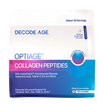Age and Age-related Disorders
The complex, multifaceted process of aging is an inherent part of life. This process, which is characterized by an irreversible decline in physiological functions and heightened risk for age-associated diseases
Study shows that Aging is a process marked by the steady accumulation of cellular and tissue damage due to various endogenous and exogenous stressors. These include genomic instability, telomere attrition, epigenetic alterations, loss of proteostasis, compromised autophagy, mitochondrial dysfunction, cellular senescence, stem cell exhaustion, altered intercellular communication, and deregulated nutrient sensing.
These cellular and molecular aberrations contribute to the functional decline of tissues and organ systems and enhance susceptibility to various chronic diseases. As the human lifespan increases, the incidence of such diseases—including neurodegenerative disorders like Alzheimer's and Parkinson's, cardiovascular conditions, metabolic diseases like diabetes, musculoskeletal conditions like osteoporosis and osteoarthritis, and immune system disorders—also rises.
As the aging process, a complex biological phenomenon witnessed across unicellular and multicellular eukaryotic organisms leads to a functional decline induced by the progressive dysregulation of cellular and organismal functions. With this aging comes an increased incidence of chronic diseases, including but not limited to cardiovascular diseases, chronic obstructive pulmonary disease, chronic kidney disease, diabetes, osteoarthritis, osteoporosis, sarcopenia, stroke, neurodegenerative diseases, and various forms of cancer.
Age-related Neurodegenerative Diseases
Aging is the most significant risk factor for neurodegenerative diseases such as Alzheimer's disease (AD), Frontotemporal Dementia (FTD), and Parkinson's disease (PD). With life expectancy significantly increasing in recent decades, these diseases have become major public health issues. The primary focus of research has been identifying biomarkers in cerebrospinal fluid (CSF) and blood to help diagnose these diseases early and monitor their progression.
However, recent research has shown an increasing interest in exosomes as a source of biomarkers for age-related neurodegenerative diseases. Exosomes are small extracellular vesicles (30–100 nm in size) released by all types of cells and originate from the endosomal compartment. They were initially thought to have a waste disposal function, but are now recognized as crucial mediators of intercellular communication.
Exosomes are found in various body fluids and can reflect pathological changes in cells in inaccessible sites such as the brain. They have been implicated in age-associated neurodegenerative processes that lead to cognitive impairment later in life. Importantly, pathological protein aggregates, including Aβ, tau, and α-synuclein, have been found in association with exosomes released from brain cells.
Moreover, exosomes also act as vehicles for the transfer of nucleic acids (DNA, mRNA transcripts, miRNA, and non-coding RNAs) between cells, potentially influencing gene expression in target cells. In this context, exosomes could help clarify the molecular mechanisms underlying neurodegenerative diseases and could represent a promising source of biomarkers.
Age-related osteoarthritis
Age is the most significant risk factor for osteoarthritis (OA), a common joint disorder and a leading source of pain and disability among the elderly. However, OA is not an inevitable outcome of aging. Radiographic changes associated with OA, especially the formation of bone spurs or osteophytes, are prevalent in older adults. Yet, joint pain symptoms often do not correlate with the severity of these radiographic signs in many older individuals.
Aging changes in the musculoskeletal system, such as cell senescence and alterations in the matrix of joint tissues, can increase the susceptibility to OA. For instance, cellular senescence can lead to the development of the senescent secretory phenotype, which contributes to the progression of OA. Also, the formation of advanced glycation end-products due to aging can affect the mechanical properties of joint tissues, promoting the development of OA.
Despite the aging factor, the joints affected and the severity of the disease are more closely related to other risk factors for OA. These include joint injury, obesity, genetic predisposition, and anatomical factors that affect joint mechanics. Even in older adults, these common risk factors remain crucial, just as they are in younger populations.
There's evidence suggesting that older adults may develop OA faster than younger adults following an acute joint injury like an anterior cruciate ligament tear. Factors such as degenerative changes in the meniscus and joint ligaments and increased bone turnover also contribute to the development of OA.
Understanding the mechanisms of joint aging could likely reveal new therapeutic targets to slow or halt the progression of OA. This is critical given the aging of our population and the increase in other OA risk factors, such as obesity. Slowing the progression of OA in older adults could have significant public health implications, potentially reducing pain and disability rates in this population. Thus, research into OA and aging continues to be of significant importance in improving the health and quality of life of the elderly.
Age-related Macular Diseases:
Age-related macular degeneration (AMD) is a severe eye condition that leads to vision loss in older adults. As one of the foremost causes of visual impairment worldwide, understanding this chronic disease is essential. AMD primarily affects the macula, the central part of the retina responsible for high-resolution vision.
There are two types of AMD that lead to significant vision loss - 'neovascular' or 'wet' AMD and 'geographic atrophy' or 'late dry' AMD. Both these advanced forms of the disease contribute to the most severe vision loss in affected individuals.
In the case of neovascular AMD, also known as wet AMD, abnormal blood vessels from the choroid, a vascular layer behind the retina, breakthrough to the neural retina. This results in the leakage of fluid, lipids, and blood, which, over time, leads to the formation of fibrous scars. The onset of wet AMD is typically sudden, and the progression of vision loss can be rapid.
On the other hand, geographic atrophy, also known as late dry AMD, is characterized by gradual and progressive atrophy or wasting away of the retinal pigment epithelium, choriocapillaris (fine blood vessels in the eye), and photoreceptors, the light-sensitive cells in the retina. This process results in a gradual loss of vision.
AMD's advanced forms are severe and can lead to central vision loss, significantly impacting the patient's quality of life by limiting their ability to read, drive, or recognize faces. Continued research and innovative treatments aim to prevent, slow, or reverse the progress of AMD, emphasizing the need for regular eye exams to detect the disease in its early stages and initiate appropriate interventions.
Age-related Oxidative Stress:
Reactive oxygen and nitrogen species (RONS) are an integral part of cellular functions and the aging process. They are generated through various endogenous (internal) and exogenous (external) processes. Endogenous sources include cellular respiration, immune cell activation, inflammation, and enzymatic reactions. Exogenous sources involve exposure to radiation, pollution, certain drugs and chemicals, unhealthy diet, and cigarette smoke.
RONS are not inherently detrimental and can play crucial roles in cellular signaling, immune response, and energy extraction from organic molecules. However, when the production of RONS surpasses the cellular antioxidant defenses, it results in a state of oxidative stress.
Oxidative stress is characterized by an imbalance between the production of RONS and the body's ability to counteract or detoxify its harmful effects through antioxidants. The accumulated oxidative damage is a significant mechanism behind aging and various age-related diseases. This premise is encapsulated in the oxidative stress theory of aging, which hypothesizes that age-related functional losses are primarily due to the accumulation of RONS-induced damage.
The relationship between oxidative stress and aging is further evidenced by its involvement in numerous age-related conditions. These conditions include cardiovascular diseases (CVDs), chronic obstructive pulmonary disease, chronic kidney disease, neurodegenerative diseases such as Alzheimer's and Parkinson's, and cancer. The aging process can also lead to loss of muscle mass and strength (sarcopenia) and decreased resilience to physical and mental stressors (frailty), both of which are linked to increased oxidative stress.
Conclusion:
Age-related diseases are a major challenge facing the world today. As the population ages, the number of people affected by these diseases is expected to increase. There is no single cure for age-related diseases, but there are a number of things that can be done to reduce the risk of developing them. These include eating a healthy diet, exercising regularly, avoiding environmental toxins, and getting enough sleep. By making these lifestyle changes, we can help to improve our health and quality of life as we age.
In addition to the above, there are a number of other things that can be done to help prevent age-related diseases. These include:
Regular check-ups: It is important to see your doctor for regular check-ups, even if you are feeling well. This is especially important as you get older, as your doctor can screen you for age-related diseases and catch them early, when they are most treatable.
Manage chronic conditions:
If you have a chronic condition, such as high blood pressure or diabetes, it is important to manage it well. This means taking your medication as prescribed, following your doctor's instructions, and making lifestyle changes to control the condition.
Health Supplements:
The right supplements can help you in your wellness journey. They can increase your healthspan by providing you with the essential nutrients that you may miss out daily diet.

















Leave a comment
All comments are moderated before being published.
This site is protected by hCaptcha and the hCaptcha Privacy Policy and Terms of Service apply.